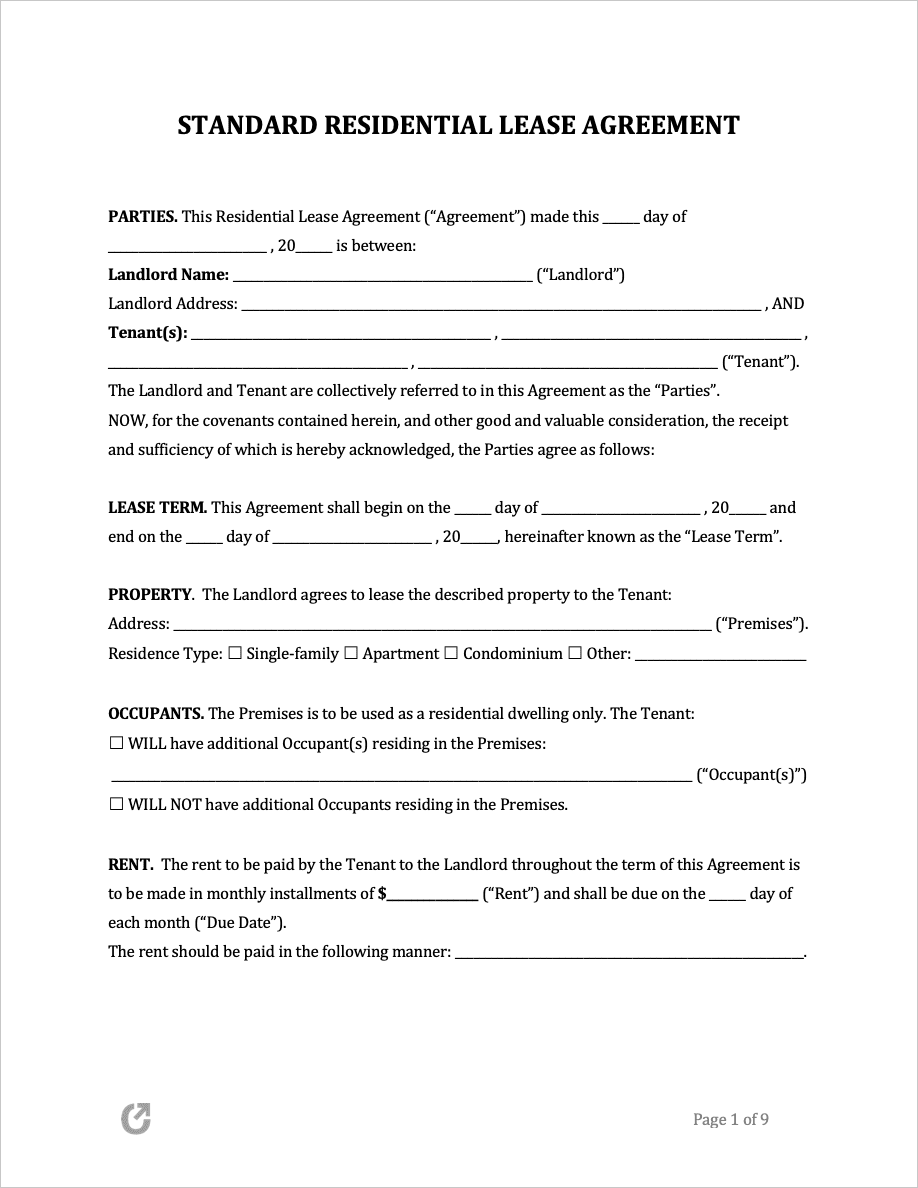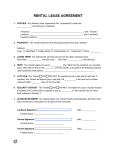Lease Agreement Templates
A lease agreement, also called a rental agreement, is a legal contract made between someone who owns and/or manages a property such as an apartment or house, and the person or people who rent it.
In exchange for rent paid in monthly, weekly, or other consistent increments, the tenants can use the property to their likes, so long it falls in line with the conditions laid out in the lease.
By State
- Alabama
- Alaska
- Arizona
- Arkansas
- California
- Colorado
- Connecticut
- Delaware
- Florida
- Georgia
- Hawaii
- Idaho
- Illinois
- Indiana
- Iowa
- Kansas
- Kentucky
- Louisiana
- Maine
- Maryland
- Massachusetts
- Michigan
- Minnesota
- Mississippi
- Missouri
- Montana
- Nebraska
- Nevada
- New Hampshire
- New Jersey
- New Mexico
- New York
- North Carolina
- North Dakota
- Ohio
- Oklahoma
- Oregon
- Pennsylvania
- Rhode Island
- South Carolina
- South Dakota
- Tennessee
- Texas
- Utah
- Vermont
- Virginia
- Washington
- West Virginia
- Wisconsin
- Wyoming
By Type (8)
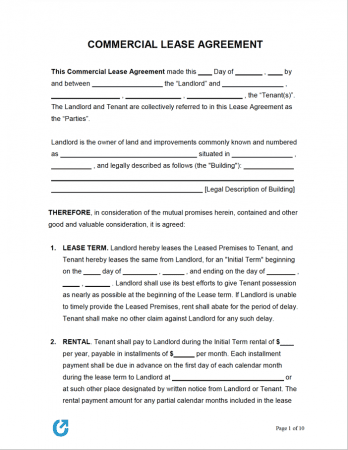 Commercial Lease Agreement – For renting out commercially-zoned real estate to a business.
Commercial Lease Agreement – For renting out commercially-zoned real estate to a business.
Download: PDF, Word (.docx)
 Lease-to-Own Agreement – Contains a provision that allows the tenant(s) to purchase the property at the end of the lease, if they so choose.
Lease-to-Own Agreement – Contains a provision that allows the tenant(s) to purchase the property at the end of the lease, if they so choose.
Download: PDF, Word (.docx)
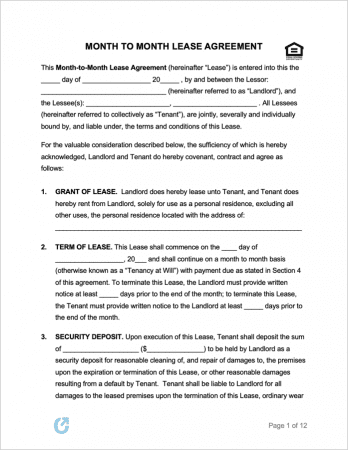 Month-to-Month Rental Agreement – A lease that exists a month at a time, with no long-term commitments. Either party can end the contract by providing a 30-day notice to the other.
Month-to-Month Rental Agreement – A lease that exists a month at a time, with no long-term commitments. Either party can end the contract by providing a 30-day notice to the other.
Download: PDF, Word (.docx)
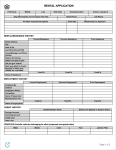 Rental Application – Used for screening tenants prior to signing a lease agreement.
Rental Application – Used for screening tenants prior to signing a lease agreement.
Download: PDF, Word (.docx)
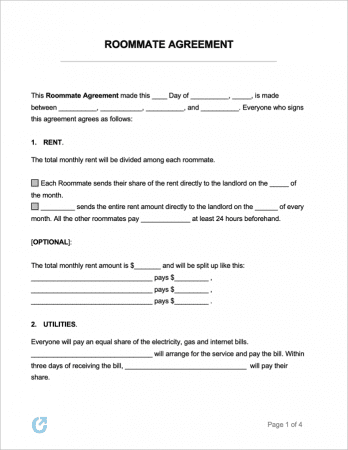 Roommate Agreement – For establishing the social rules of a shared apartment or home. For college and university students, download the college (dorm) roommate agreement.
Roommate Agreement – For establishing the social rules of a shared apartment or home. For college and university students, download the college (dorm) roommate agreement.
Download: PDF, Word (.docx)
Simple (1 Page) Lease Agreement – A basic rental document that contains the bare minimum necessary for creating a binding landlord-tenant contract.
Download: PDF, Word (.docx)
 Standard Residential Lease Agreement (Popular) – The most common type of rental contract. Used for renting out homes, apartments, and other properties to rent-paying tenants.
Standard Residential Lease Agreement (Popular) – The most common type of rental contract. Used for renting out homes, apartments, and other properties to rent-paying tenants.
Download: PDF, Word (.docx)
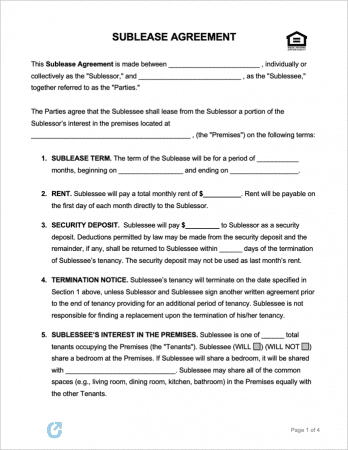 Sublease Agreement – Gives tenants that are locked into a lease a way of re-renting their room, apartment, or home to new a new tenant.
Sublease Agreement – Gives tenants that are locked into a lease a way of re-renting their room, apartment, or home to new a new tenant.
Download: PDF, Word (.docx)
How to Lease a Property
Below is a guide on the leasing process for residential properties. Learn the basics on how to market the property, show the premises to a suitable tenant, obtain their personal information for a credit and background check, and begin collecting rent by signing a lease agreement.
Step 1 – Determine the Rent

Prior to listing the rental, the landlord should ensure the unit is clean, damage-free (not including standard wear and tear), and compliant with local building codes and regulations. All valuable and/or sentimental possessions should be removed as well.
Next, the landlord will need to determine the property’s rent. This is an important decision, as too high of a rent price can cause the property to remain vacant, whereas too low of a price could result in an overwhelming number of applicants (and lost income on the end of the landlord).
As a general rule, the rent price should:
- Cover all operating expenses (taxes, repairs, utilities, mortgage, etc.);
- Be in line with the current state of the market (renters or buyers market, for example);
- Closely resemble what similar rentals are going for in the area, and;
- Reflect the value of the home or building (typically .8-1.1% of the property value)
Step 2 – Advertise + Tour the Rental

Once the property is ready for occupants, the landlord can begin advertising the rental. A few popular and time-tested means of finding tenants are as follows:
- Free Online Rental Marketplaces
The majority of apartment-seekers head to online marketplaces where they can browse for rentals that meet their requirements. Filters allow them to search based on rent price, square feet, baths, appliances, and much more. When creating the listing, it’s important the landlord provides as many facts and details about the property as possible. The more characteristics landlords include the more likely they’ll fill the unit’s vacancy.
Popular options: Zillow | Craigslist | Realtor.com
- Digital Newspapers
The classified section of newspapers is a great way to get the word out to potential tenants. While the option is never free, it can help landlords get the word out to those that could be looking for rentals in the future, and that don’t browse rental listing sites. Setting this up is as easy as visiting the newspaper’s advertising page and sending out an email to the party responsible for ads.
- Yard Signs
Although it’s the simplest option of those provided, placing a sign in the yard or window of the rental property is free exposure that is visible to everyone that passes by. Unlike online marketplaces, a physical sign can inform people of the vacancy that wouldn’t be exposed to it otherwise. This can help spread knowledge of the available rental to those that are in the market for signing a new lease.
Step 3 – Screen Tenants

If the apartment or home fits the tenant’s expectations and requirements, they will request to sign a lease. It’s at this time that the landlord will request the tenant(s) to complete a rental application. Due to the liability involved with renting, landlords need as much information as possible in order to ensure the tenants moving in to their property are responsible and trustworthy. Landlords should never lease to a tenant that they haven’t properly vetted.
During the screening phase, landlords should obtain the following:
- Basic Tenant Info – Includes the name of the applicant along with certain identifying information, such as their Social Security Number, full name, address, email, phone number, and driver’s license number.
- Employment Information – To get an idea as to whether or not the tenant can afford rent payments, the landlord will need to collect the applicant’s employment information. This can be in the form of tax documents, paychecks, or the contact info of a boss or employee who can verify the tenant’s income and job status.
- Rental History – Landlords will almost always reach out to an applicant’s past landlords to get an honest and accurate depiction of the type of renter the prospective tenant is. Additionally, they will often require applicants to list several referrals that the landlord can contact as well.
- Credit + Background Check (Separate to the Rental Application) – While not always required in a rental application, the landlord may request the rental candidate to pay for a credit check. Like employment information, the credit check gives insight into whether the applicant is likely to be timely with their rental payments. Missed payments on loans, bills, and any accumulated debt will be available to the landlord.
Step 4 – Create a Lease Agreement

Alongside identifying viable tenants, creating a comprehensive lease agreement is one of the most important tasks landlords face. Leases serve a very important role in the rental process, which is reinforced by the fact that they:
- Serve as proof that the tenant(s) committed to leasing a property for a certain length of time;
- Bind tenant(s) into an obligation of paying timely rent;
- Ensure all parties are clear on their obligations and the rules they must follow;
- Protect the rights of the landlord and tenant(s); and
- Are the go-to resource for resolving disputes and arguments.
Step 5 – Negotiate the Details

Once an interested tenant has been found and the landlord approves of their rental application, the parties will sit down and discuss the terms and conditions found within the lease. The landlord should go section-by-section through the entire agreement, clarifying any confusing clauses and answering any questions the tenants pose.
If the tenants do not approve of a certain section, they will most likely attempt to negotiate it with the landlord. If the landlord owns a highly-desirable property, they might not negotiate at all. However, if the tenant is exceptional and the tenant’s request isn’t unreasonable, being open to negotiation can be worthwhile.
Important note: It is not the landlord’s responsibility if a tenant skims through the agreement, signs it, and later complains of a condition found within the form. It is the tenant’s responsibility to ensure they agree with all conditions. However, landlords cannot include a section in the agreement that conflicts with state law or the Federal Fair Housing Act.
Step 6 – Sign the Agreement

At this point, the tenant(s) should have read through the entirety of the agreement and discussed any questions or concerns. Once all questions have been resolved, all parties should sign the agreement, either in-person or online.
Having the lease notarized is not required and is rarely done by landlords. While doing so can technically improve the document’s validity, it is generally viewed as non-essential.
Step 7 – Collect Deposits + Move-in Checklist

With the lease signed, the tenants will be bound to renting the property for the duration stated in the contract. To cover property damage, a missed payment, or other penalties/fees, the landlord should require the tenant(s) to pay a security deposit. The amount is typically equivalent to one (1) months’ rent, although certain states have no limits on the amount that can be charged. In addition to the deposit, the landlord should collect the first month’s rent.
After receiving all deposits in full, the landlord should complete a condition checklist with the tenants. This is a form used for recording any damage/missing items within the rental property. Once the checklist has been completed and all initial payments have been received, the landlord should give the tenant(s) the keys and allow them to move into the property, completing the rental process.
Landlord-Tenant Laws
The following are each state’s property management laws.
Maximum Security Deposits
A security deposit is a payment made by the tenant at the start of the lease to cover property damage, missed payments, and other issues. If the tenant takes care of the property and doesn’t miss any payments, the landlord will return the deposit in full to the tenant. The table below outlines the maximum amount ($) that can be collected for a security deposit in each state.
| STATE | MAXIMUM DEPOSIT |
| Alabama | One (1) month’s rent (with exceptions) |
| Alaska | Two (2) month’s rent (with exceptions) |
| Arizona | One and a half (1.5) month’s rent |
| Arkansas | Two (2) month’s rent |
| California | Two (2) month’s rent |
| Colorado | No limit |
| Connecticut | Two (2) month’s rent (with exceptions) |
| Delaware | No limit (for the first rental year) |
| Florida | No limit |
| Georgia | No limit |
| Hawaii | One (1) month’s rent (with exceptions) |
| Idaho | No limit |
| Illinois | No limit |
| Indiana | No limit |
| Iowa | Two (2) month’s rent |
| Kansas | One (1) month’s rent (with exceptions) |
| Kentucky | No limit |
| Louisiana | No limit |
| Maine | Two (2) month’s rent |
| Maryland | Two (2) month’s rent |
| Massachusetts | One (1) month’s rent |
| Michigan | One (1) and a half month’s rent |
| Minnesota | No limit |
| Mississippi | No limit |
| Missouri | Two (2) month’s rent |
| Montana | No limit |
| Nebraska | One (1) month’s rent (w/ exceptions) |
| Nevada | Three (3) month’s rent |
| New Hampshire | One (1) month’s rent or $100 (w/ exceptions) |
| New Jersey | One and a half month’s rent (1.5) (contains exceptions) |
| New Mexico | One (1) month’s rent |
| New York | One (1) month’s rent |
| North Carolina | One (1) and a half month’s rent (with exceptions) |
| North Dakota | One (1) month’s rent (with exceptions) |
| Ohio | No limit |
| Oklahoma | No limit |
| Oregon | No limit |
| Pennsylvania | Two (2) month’s rent (with exceptions) |
| Rhode Island | One (1) month’s rent |
| South Carolina | No limit |
| South Dakota | One (1) month’s rent (contains exceptions) |
| Tennessee | No limit |
| Texas | No limit |
| Utah | No limit |
| Vermont | No limit |
| Virginia | Two (2) month’s rent |
| Washington | No limit |
| West Virginia | No limit |
| Wisconsin | No limit |
| Wyoming | No limit |
Deadline For Returning Deposits
After the lease has ended, landlords need to return the security deposit (or whatever remains of the deposit) to the tenant(s) within a certain length of time.
| STATE | DEADLINE |
| Alabama | Sixty (60) days after the termination of the tenancy |
| Alaska | Fourteen (14) days if the tenant provides the proper notice (of their vacancy); Thirty (30) days otherwise. |
| Arizona | Fourteen (14) days after the termination of the lease (not including weekends & holidays) |
| Arkansas | Sixty (60) days after the termination of the lease |
| California | Twenty-one (21) days after the tenant(s) move out, or within sixty (60) days after the termination of a fixed-term lease |
| Colorado | One (1) month after the termination of the lease, or the tenant moves-out of the rental |
| Connecticut | Upon receiving the tenant’s mailing address, fifteen (15) days; upon the termination of the tenancy, thirty (30) days (whichever is less) |
| Delaware | Twenty (20) days after the termination of the lease |
| Florida | If no deductions, fifteen (15) days. If deductions are made the deposit, thirty (30) days |
| Georgia | Thirty (30) days after the tenant moves out of the rental |
| Hawaii | Fourteen (14) days after the lease officially ends |
| Idaho | Within thirty (30) days if established by the lease; twenty-one (21) days if not |
| Illinois | If the landlord makes deductions from the deposit, thirty (30) days; if no deductions, forty-five (45) days |
| Indiana | Forty-five (45) days after the termination of the lease |
| Iowa | Thirty (30) days after the tenant(s) have moved out and provided the landlord with a forwarding address |
| Kansas | Fourteen (14) days after the tenant requests the deposit; thirty (30) days otherwise |
| Kentucky | Landlords must send a notification stating the tenant’s refund owed. If no response is heard within sixty (60) days, they can keep the deposit |
| Louisiana | One (1) month after the end of the lease |
| Maine | Twenty-one (21) days for periodic leases; thirty (30) days for fixed-term leases |
| Maryland | Forty-five (45) days after the end of the lease (with interest) |
| Massachusetts | Thirty (30) days after the termination of the rental contract |
| Michigan | Thirty (30) days after the official end of the lease |
| Minnesota | Three (3) weeks after the end-date of the lease; five (5) days if the tenant was forced. to leave the rental due to no fault of their own |
| Mississippi | Forty-five (45) days after the lease is officially terminated |
| Missouri | Thirty (30) days after the termination of the tenancy |
| Montana | Ten (10) days if no deductions and unpaid debt; thirty (30) days otherwise |
| Nebraska | Fourteen (14) days after the termination of the lease |
| Nevada | Thirty (30) days within the termination of the rental agreement |
| New Hampshire | Thirty (30) after the lease is terminated |
| New Jersey | Thirty (30) days after the rental contract is terminated |
| New Mexico | Thirty (30) days starting from the lease’s end |
| New York | Fourteen (14) days after the tenant(s) have moved out of the premises |
| North Carolina | If no deductions, thirty (30) days. If deductions, sixty (60) days. |
| North Dakota | Thirty (30) days within the termination of the lease |
| Ohio | Thirty (30) days after the lease is terminated and the landlord takes possession of the rental |
| Oklahoma | Forty-five (45) days after 1) the lease ends, 2) the tenant(s) have moved out, and 3) they have requested their deposit |
| Oregon | Thirty-one (31) days after the lease ends and the tenant(s) have moved out |
| Pennsylvania | Thirty (30) days after the termination of the lease, or after the tenant(s) move out (whichever comes first) |
| Rhode Island | Twenty (20) days after the tenant provides the landlord with a new forwarding address, they move-out, or the lease ends (whatever comes last) |
| South Carolina | Thirty (30) days after the tenants move out, provide the landlord with a new address, and request the deposit |
| South Dakota | Two (2) weeks. Must provide a list of any deductions (if requested by tenants) within forty-five (45) days after the termination of the lease |
| Tennessee | Thirty (30) days after the tenant(s) have moved out, or seven (7) days after new tenant(s) move in |
| Texas | Thirty (30) days after the tenant(s) leave the rental |
| Utah | Thirty (30) days starting from the date the tenant(s) move out |
| Vermont | Fourteen (14) days after receiving notice or discovering the property was vacated; sixty (60) days for non-permanent rentals and seasonal tenancies |
| Virginia | Forty-five (45) days after the termination of the lease |
| Washington | Twenty-one (21) days after the tenant(s) move out of the rental |
| West Virginia | Sixty (60) days after the termination of the lease; forty-five (45) days if the rental is re-leased |
| Wisconsin | Twenty-one (21) days after the tenants have moved out of the rental |
| Wyoming | Thirty (30) days after the termination of the lease or fifteen (15) days after the landlord receives the tenant’s forwarding address. If damage to the rental, landlords can have an additional thirty (30) days |
Required Notice for Entry
Prior to entering a property for inspection, repairs, showings, and other non-emergency reasons, a notice might have to be provided. The following table provides each state’s notice requirements regarding entering a rental unit.
| STATE | REQ. NOTICE TO ENTER |
| Alabama | Two (2) days (§ 35-9A-303(c)) |
| Alaska | Twenty-four (24) hours (§ 34.03.140(c)) |
| Arizona | Two (2) days (§ 33-1343(d)) |
| Arkansas | N/A |
| California | Twenty-four (24) hours (§ 1954(2)) |
| Colorado | N/A |
| Connecticut | Adequate notice (§ 830-47a-16(d)) |
| Delaware | Two (2) days (§ 5509(b)) |
| Florida | Twelve (12) hours (§ 83.53(2)) |
| Georgia | N/A |
| Hawaii | Two (2) days (§ 521-53(b)) |
| Idaho | N/A |
| Illinois | N/A |
| Indiana | Adequate notice (§ 32-31-5-6(g)) |
| Iowa | Twenty-four (24) hours (§ 562A.19 A(3)) |
| Kansas | Adequate notice (§ 58-2557(a)) |
| Kentucky | Two (2) days (§ 383.615(3)) |
| Louisiana | N/A |
| Maine | Twenty-four (24) hours (§ 6025(2)) |
| Maryland | N/A |
| Massachusetts | Adequate notice (§ 15B(1)(a)) |
| Michigan | N/A |
| Minnesota | Adequate notice (§ 504B.211(Subd 2)) |
| Mississippi | N/A |
| Missouri | N/A |
| Montana | Twenty-four (24) hours (§ 70-24-312(2)) |
| Nebraska | One (1) day (§ 76-1423(3)) |
| Nevada | Twenty-four (24) hours (§ 118A.330(3)) |
| New Hampshire | Adequate notice (§ 540-A:3(V)) |
| New Jersey | N/A |
| New Mexico | Twenty-four (24) hours (§ 47-8-24(1)) |
| New York | N/A |
| North Carolina | N/A |
| North Dakota | Adequate notice (§ 47-16-07.3(2)) |
| Ohio | Twenty-four (24) hours (§ 5321.04(8)) |
| Oklahoma | One (1) day (§ 41-128(C)) |
| Oregon | Twenty-four (24) hours (§ 90.322(b)) |
| Pennsylvania | N/A |
| Rhode Island | Two (2) days (§ 34-18-26(c)) |
| South Carolina | Twenty-four (24) hours (§ 27-40-530(c)) |
| South Dakota | Twenty-four (24) hours (§ 43-32-32) |
| Tennessee | Twenty-four (24) hours (§ 66-28-403(e)(5)) |
| Texas | N/A |
| Utah | Twenty-four (24) hours (§ 57-22-4(2)) |
| Vermont | Forty-eight (48) hours (§ 4460(b)) |
| Virginia | Twenty-four (24) hours (§ 55-248.18(A)) |
| Washington | Two (2) days (§ 59.18.150(6)) |
| West Virginia | N/A |
| Wisconsin | Adequate notice (§ 704.05(2)) |
| Wyoming | N/A |
Frequently Asked Questions (FAQ)
Can I Electronically/Digitally Sign a Lease?
Yes, any person can electronically or digitally sign a lease agreement. Created in October 2000, the E-Sign Act made it possible for individuals to electronically sign documents instead of entering their signatures by hand. Landlords seeking to collect legitimate, digitally secure tenant signatures can use eSign.com.
What Happens if a Tenant Breaks the Lease?
If a tenant breaks the lease, the landlord should take action immediately. First, they must review the terms listed in the mutually signed lease agreement. This information will advise the tenant of the mandatory steps to take should the tenant stop paying their rent. In most cases, this process includes the following:
- Reaching out to the tenant via a letter. Clearly state that they still have an obligation to pay for all remaining rental payments in full, by their pre-arranged due dates.
- Inspecting the property. Take a detailed report of any damage. If severe (and the tenant is unwilling to pay for it), taking them to small claims court will most likely be required.
- Taking the security deposit. Generally, state laws permit the taking of the tenant’s security deposit to cover unpaid rent. This should be done prior to taking the tenant to small claims court.
- Finding a new tenant. Each passing month without a new tenant costs the property owner money. Additionally, many state laws prevent landlords from collecting rent from the tenant unless they are actively looking for a replacement. If a new tenant is found and moved into the property, the landlord CAN NOT continue charging the previously evicted tenant rent.
- If the tenant is refusing to pay rent and the landlord hasn’t been able to find a replacement (although they should still be trying to), they can proceed to the “worst-case scenario,” which is suing the tenant. While it should be relatively straightforward once an attorney has been contacted, there is never a guarantee.
Important Exceptions:
In some cases, a tenant can lawfully vacate a rental. They are the following:
- Uninhabitable Rental: If the property is unsafe, doesn’t provide access to clean/hot water, leaks, is heavily infiltrated by mold, doesn’t have locking doors, or contains pests, for example, the tenant can legally breach the lease.
- Military Duty: In accordance with the Servicemembers Civil Relief Act (SCRA), the tenant can vacate a lease so long they give the landlord a notice of at least thirty (30) days.
- The Landlord Breached the Lease: Like tenants, landlords are equally responsible for holding up their end of the lease as well as following all state landlord-tenant laws. For example, if the landlord repeatedly showed up (without notice) in a state that requires a minimum of twenty-four hours of notice, the tenant may have a legal right to vacate the lease without notice (or very short notice).
Is a Lease Agreement Legally Binding?
Yes. Once signed by the landlord and tenant(s), it binds them to the conditions included, so long the rules and obligations comply with state and federal laws. While the agreement as a whole is legally binding, it’s important to know that not all of the sections can be enforced by a court of law.
For example, if the rental agreement contains a condition that requires the tenant(s) to keep silent about a part of the building/premises that doesn’t comply with local building codes, the tenant(s) do not have to comply with the condition. Rather, they should first inform the landlord of the issue in writing (following the required notice periods), followed by the local/city housing authority if no response is received.
What about a verbal lease agreement?
Yes. While verbal leases are not recommended, state laws view them as legally binding agreements. However, due to the difficulty of enforcing the conditions and proving what was agreed-upon, they should only be used in situations where the parties have extreme trust in one another (family, for example), or are leasing a property that the landlord will also share (a single room, for instance).
Lease Agreement vs. Rental Agreement?
“Lease agreement” and “rental agreement” are terms that are often used interchangeably to refer to a binding agreement over the right to live or work in a residential/commercial property. Although commonly used to mean the same thing, they differ in the term (duration) of their contracts.
- Lease agreement – Used for leasing property on a long-term basis, typically in yearly (12-month) increments. With the contract, the end-date is known and the parties have a clear understanding of the total rent payments to be made (and when).
- Types: Standard Residential Lease Agreement | Lease to Own Agreement | Commercial Lease Agreement
- Rental agreement – Although containing many of the same conditions as a lease agreement, a rental agreement is used for short-term rental arrangements with no set end-date. Often called “periodic tenancies”, a rental agreement exists for one (1) rental term at a time where it automatically renews so long the landlord or tenant(s) do not wish to terminate it. If they do decide to end the lease, they have to provide the other party with a notice of one (1) month (or another agreed-upon notice).
- Types: Month-to-Month Lease/Rental Agreement
Does a Lease Have to be Notarized?
Notarization is the process of having a certified third (3rd) party officially verify a signature on a legal document. Generally, lease agreements do not have to be notarized. However, certain states, such as Ohio, require leases longer than three (3) years to be certified by a Notary Public.
Although it’s not required, having a lease be notarized is an additional means of security, ensuring a lease agreement is enforceable in a court of law.
Can a Lease be Terminated Before a Tenant Moves In?
Possibly. From a landlord’s point of view, the answer depends on whether or not their right to terminate is stated in the lease agreement. For a tenant, it also depends on the written lease, but also state law, which can provide the tenant with room for exiting the lease without incurring damages and other costs. In this situation, it’s in the best interest of landlords and tenants to provide notice to the other party of their intent to terminate the lease as soon as possible and try to come to an agreement on their own without involving litigation.
Glossary
- Abandon / Abandonment – A tenant’s voluntary action of leaving the rental property prior to the lease’s end, and without providing notice to the landlord.
- Arbitration – The act of including a third (3rd) party to listen to an argument, who will then make a final decision.
- Arbitrator – The person involved in arbitration that makes the final decision regarding a dispute.
- Assign / Assignment – The act of permitting a secondary tenant (the sublessee) to live in a rental property in replacement of (or alongside) the original tenant (the sublessor). Also known as subleasing.
- Binding – Commonly used in the phrase “binding agreement” or “binding contract”, refers to a set of obligations, rules, terms, and other conditions that cannot be broken/breached.
- Co-tenant – A roommate; a tenant that shares the same rental property with another tenant.
- Contract – An agreement that binds two (2) or more parties to a number of requirements, obligations, and/or statements.
- Credit Report/Check – Used by landlords during the application process to view an applicant’s credit score, payment history, loans, and to generally see if there’s a good indication that the tenant will make timely payments.
- Discrimination – The illegal, unjust treatment of applicant tenants over topics out of their control (race/color, nationality, religion, disability, sex, age, and familial status).
- Escrow account – In renting, an escrow account is a bank account that tenants deposit their rent into. The account is managed by the local municipality’s clerk’s office, who only pays out rent to landlords that comply with local housing codes or whatever the requirements were when the account was initially created.
- Eviction – The forced act of removing one (1) or more tenant(s) from a unit due to their non-compliance with the lease.
- Notice to Quit/Eviction Notice – A written notice given by the landlord to their tenant(s) stating the tenant(s) have to leave the rental by a certain date. Only used when the tenant(s) breached the lease.
- Guest – An individual temporarily living/staying in a rental property. Invited by the tenant(s).
- Habitable / Livable – A rental property that is in good enough condition to warrant the tenant(s) to live in it.
- Holding Deposit – A monetary payment made from a tenant to a landlord to “hold” the rental property for a certain length of time, ensuring the landlord does not lease it to a different tenant.
- Landlord – The party responsible for managing the rental and overseeing the tenant(s). Is often the owner of the property (but doesn’t have to be).
- Lease – A form used for specifying the details of a situation in which a property/unit/room is rented to one (1) or more tenants.
- Lock-out – The act of preventing tenant(s) from entering a rental unit via changing the locks or similar action. Used when tenant(s) are late on rental payments. Typically an illegal action.
- Mediation – Used for resolving disputes. Includes a third (3rd) party that listens to the arguments of both sides and assists them in coming to a mutual decision.
- Negligence – An action that doesn’t take other people’s care and wellbeing into consideration. A mistake due to an obviously unreasonable decision.
- Periodic Tenancy – A type of short-term lease that has no pre-defined end-date. Can be terminated by the landlord or tenant so long appropriate notice is given.
- Rent control ordinance – A local government restriction on the amount landlord’s can demand for rent. Common in large cities.
- Rent withholding – The purposeful nonpayment of rent due to a landlord’s noncompliance with the lease. Legally permitted in some states.
- Rental Period – The length of time between rent payments. Can be a year, a month, a week, or another pre-determined timeframe.
- Renter’s Insurance – Purchased by tenants, covering them from liability in the event their possessions are destroyed by fire, flooding, theft, a broken pipe, and more.
- Security Deposit – A monetary payment given from tenants to a landlord at the start of the lease. Used for covering unexpected damage, missed rental payments, and more. Landlords are required to return the deposit at the end of the lease if no deductions need to be made.
- Sublease – The act of introducing a second (2nd) tenant to live in the property alongside, or in replacement of, the original tenant.
- Sublessee – The individual living in the property in replacement of the sublessor. Also known as the “subtenant”.
- Sublessor – The original tenant to a rental property. Acts as the sublessee’s landlord.
- Subpoena – A document that legally requires a person to attend court.
- Tenant – The party paying rent in exchange for the right to live/work in the property. Also known as the ‘lessee’, ‘renter’, or ‘occupant’.
- Termination notice (for periodic leases) – A written notice delivered by the landlord or tenant signifying they wish to terminate the lease agreement. Typically provided thirty (30) days in advance of the next rental payment.
- Warranty of habitability – A guarantee that the rental property will be livable for tenants for the full length of the lease term.
